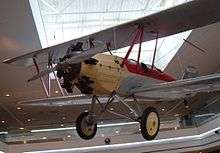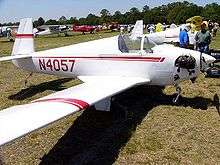Albert Mooney
| Albert W. Mooney | |
|---|---|
| Born |
12 April 1906 Denver, Colorado |
| Died |
7 May 1986 (aged 80) Dallas, Texas |
| Known for | Mooney Aircraft Company |
Albert W. "Al" Mooney (12 April 1906 – 7 May 1986) was a self-taught aircraft designer. Al, along with his brother Arthur, was responsible for the startup of the Mooney Aircraft Company which started with the M-18 Mite.[1]
Early life
Background
Al Mooney's technical background stemmed from his father's job as an engineer building railroad trestles for the Denver & Rio Grande. In the time spent with his father, Al learned the concepts of drafting and layout work.[1] His initial interest in airplane design began while still in grade school and continued to grow as he progressed to high school. While in high school, he realized he excelled at mathematics, and many possibilities lie within it.[2] Seeking information on aircraft, Al asked his teacher what he should study that would best allow him to design safe airplanes. Al's teacher responded to him by saying there was no such thing as a safe aircraft and recommended he wait until college before pursuing the topic any more.[1] Realizing his current schooling would give him very slim chance of learning the things he wanted to know, he began spending time at the Denver Public Library, where he read all of the available handbooks for pilots and designers.[2]
Early career

After graduating from high school, Al's plans of attending the Colorado School of Mines were changed by an encounter with a Swallow biplane that flew over an area where he was working. Following the aircraft to the local airfield, Al noticed several mistakes in the aircraft rigging which he gladly offered to help fix. After rerigging the plane, which was flown by J. Don Alexander, he was offered a job at the Alexander Aircraft Company.[1] At the age of 19, Al took the job as an assistant to the chief engineer and draftsman at the Alexander Company in Denver.[3] His early years proved unfruitful with his assistance on an eventually failing design. Finally, Al got the chance to build the M-1, also known as the Long Wing Eaglerock, a plane of his own design. While the airplane had some success as a trainer, its success was not enough to keep him at the Alexander company. In 1926, after spending some time working for Montague, where he designed his M-2, Al started taking his first flying lessons. Eventually, after the financial demise of Montegue, Al returned to Alexander.[1] In 1928, he became the chief engineer at Alexander.[1] During the time as chief engineer, he was responsible for several advances in the field of aircraft design, primarily through design of the Bullet, which was a low- wing airplane with relatively high speeds and a patented retractable landing gear.[3]
Production years
The first Mooney Aircraft Company
In 1929, with the financial backing of the Bridgeport Machine Co.,[1] Al left the Alexander Aircraft Corporation. Along with his brother Arthur, they moved to Wichita, Kansas, where they started the Mooney Aircraft Corporation. The early years of the Mooney Corporation were spent designing the Mooney A-1, which had similar characteristics to the Bullet which Al had designed earlier, and the M-5.[3] Within seven months of startup, the design of Al's M-5 had progressed from the drawing board to test flights. With the aircraft industry sales on the decline due to the onset of the great depression, Al attempted to fly the M-5 nonstop from Glendale, California, to Long Island, New York, as a promotional feat. However, the nonstop flight failed near Fort Wayne, Indiana, when his engine quit due to faulty welding on the fuel pump.[1] In 1931, with the failing economy, the Mooney Corporation closed its doors.[3]
In the time after the liquidation of the Mooney Aircraft Company, Al continued to pursue aircraft design. His next design began as drawings for a new plane, the M-6, which sported a two-place low-wing design. However, development came to a halt with financial difficulty that prevented the purchasing of an engine. After several years of searching for financing and continuing design, the M-6 fell through the cracks and never made production.[1]
Bellanca and Culver
While most of the aircraft industry was in shambles in the middle of the great depression, the Bellanca aircraft company had some continued success due to contracts with the navy and the company's popularity among Alaskan bush pilots. In 1934, Mooney took a job as the chief engineer at Bellanca.[3] During this period, Mooney worked closely with the owner, the well-respected Giuseppe Bellanca. In his time at Bellanca, Mooney was responsible for the designs of the Bellanca Airbus cargo plane and the racer Irish Swoop.[1]
After his time with Bellanca, Mooney went briefly to Monocoupe Corporation. Working with the small startup company, he designed the Model G Dart and the Monocoach.[3] In his time with Monocoupe, several features of future Mooney aircraft were designed. These enhancements included rubber shock biscuits and a spring-assisted manual gear.[1] After Monocoupe went under due to financial distress, Mooney's designs were purchased by Culver Aircraft.
In 1937, Mooney joined Culver as chief engineer. In his days at Culver before World War II, he was responsible for the design of the Culver Cadet acrobatic plane which had a production of over 350 models.[3] By the 1940s, Culver's main focus shifted towards military drones, in which Mooney had little interest. During this time, Mooney started a business relationship with Al Yankey, which eventually led to the founding of a second Mooney Aircraft. As Culver's commercial sales began to slow down with the end of the war, and the tough competition from the Cessna 120, Mooney left the company.[1]
The second Mooney Aircraft Company

In July 1946, with the partnership of C.G. Yankey and W.L. McMahon, Al and Art resurrected the Mooney Aircraft Corporation. In the new company, Al took the position of general manager and chief engineer.[3] The first aircraft produced was the M-18, a single-place retractable gear aircraft, and the first of its kind available on the market after World War II; it was later named the Mite.[1] After some problems with engine selection and the decision to replace them, Al started design on his next aircraft, the M-20. The M-20 he envisioned was a four-place design with the eventual capability to convert to metal manufacturing. in 1953, the corporation's main financial backer, Al Yankey, died of a stroke before proper funding had been set up for Al's M-20. With the company again in financial distress, it was taken over by Hal Rachal and Norm Hoffman. Only two years after the first prototype flight of the M-20, and in the wake of Yankey's death followed by the company's takeover, Al left the Mooney Aircraft Company and started working at Lockheed.[1]
The later years
Lockheed
After leaving the Mooney Aircraft Company, a company in which he had no ownership, though it carried his name, he moved to Lockheed, where he spent the rest of his career. In his time with Lockheed, his aircraft designs continued with a proposal that eventually became the Lockheed Jetstar. Other designs credited to him include the AL-60 and another unnamed Lockheed business jet.[1]
Retirement
In 1964, while Al was designing his final aircraft, a benign tumor was found in his wife Opie. This was the beginning of a decline in her health, ending with her death in 1966. His initial response to her death was to lose himself in his work. However, when his older brother Art retired in 1967, he realized that he was no longer enjoying his work, and retired in 1968. On 7 May 1986 in Dallas, Texas, Al died at the age of 80.[1]
References
- 1 2 3 4 5 6 7 8 9 10 11 12 13 14 15 16 "The Al Mooney Story:They All Fly Through the Same Air". Archived from the original on 28 January 2007. Retrieved 2007-01-30.
- 1 2 Rank, Dick (1975). "An Interview with Al Mooney". International Mooney Society. Retrieved 2008-01-21.
- 1 2 3 4 5 6 7 8 "Mooney Aircraft history performance and specification". Retrieved 2006-01-31.